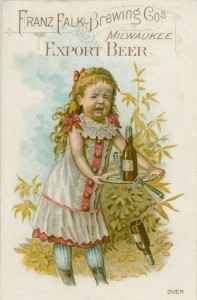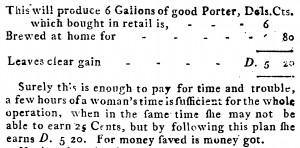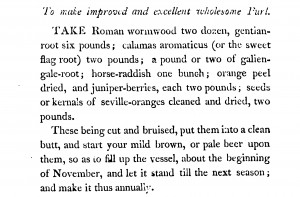Making beer, hard cider, and other spirits at home has long been part of American culture. Most students of American history know this and know that both genders consumed alcohol and that children did as well. I was surprised though, to learn how much alcohol was consumed. According to Sarah Hand Meacham in her book Every Home a Distillery: Alcohol, Gender and Technology in the Colonial Chesapeake (Baltimore: Johns Hopkins Press, 2009), “[b]y 1770, the average white adult male had the equivalent of seven shots of rum per day, and an average white woman drank almost two pints of hard cider per day.” Apparently, consuming mass quantities did not start with the Coneheads. 
For anyone interested in early American brewing, from technique to recipes, from the economics to societal impacts, the American Antiquarian Society has some great resources. The collections include reference works like the aforementioned Meacham title, but also, naturally, the Society has 18th and 19th century works aimed at the home brewer. One great example is Every Man His Own Brewer, A Small Treatise, Explaining the Art and Mystery of Brewing Porter, Ale and Table-Beer, by Samuel Child (Philadelphia, 1796) (available digitally through Readex’s Early American Imprints, Series I: Evans, 1639-1800). This treatise was originally published in London but Philadelphia publisher Thomas Condie (1775?–1814) reprinted and edited it for the American audience. Evidently the recipe (called receipts in the pamphlet) for porter was a closely held secret in the late 18th century but Child, who opined “for celebrity, universal use and estimation Porter as not been equaled by any other liquor,” wanted to reveal the secret for the benefit of the lower classes.


Child’s recipes include prices (which Condie has edited to reflect American currency) and comparisons to equivalent portions purchased commercially. He calculates the savings for us so we can easily justify the effort expended. Child’s recipes include some exotic ingredients like cocculus indicus, coriander, and capsicum, the former two of which were banned by British Acts of Parliament for their “poisonous and stupefactive” qualities. Child, ever the iconoclast, tells us he uses them anyway (Condie tells us not to). Lastly, the treatise includes explanations of the techniques and equipment necessary to brew porter and the other recipes. With a little effort (Child’s play?) and a little research, one can see oneself making these 18th century brews.
Two other works from the AAS collection expound the health and economic benefits of brewing at home. The Complete Family Brewer; or The Best Method of Brewing or Making any Quantity of Good Strong Ale and Small Beer, In the Greatest Perfection, for the Use of Private Families; from a Peck of Malt to 60 Bushels (Philadelphia, Graves, 1805) appears nine years after the Condie title, and is much easier for the modern reader to comprehend (it is also available digitally through Readex’s Early American Imprints, Series II: Shaw-Shoemaker, 1800-1819). 
The third work is a book written by an M.D, Marcus Lafayette Byrn (1826–1903) lending credence, no doubt, to the salutary effects of consuming one’s own beer. The Complete Practical Brewer; or, Plain, accurate, and thorough instructions in the art of brewing ale, beer, and porter : including the process of making Bavarian beer; also, all the small beers … Adapted to the use of public brewers, and private families, or those who may wish to brew on a small scale : With numerous illustrations, by M.L. Byrn, M.D. (Philadelphia: Henry Carey Baird, 1852). It runs to nearly 200 pages and is therefore much more comprehensive than the pamphlets. This work, which had numerous editions, includes chapters for commercial operations (e.g., there are instructions with diagrams for building kilns to malt your own grain) but also includes chapters for “private families.” In addition to a great deal of advice on technique, Dr. Byrn (who also published a book on distilling spirits — I am not sure the AMA would approve) provides numerous and sundry recipes for potables such as Burton Ale, Welsh Ale, Reading Ale, Currant Wine, Mead, Ciders, Root Beer, Ginger Pop, and Scurvy-Grass Ale (“considered a rectifier of the blood” and “highly recommended by some medicinal men”).
These works and the many other brewing related materials at the AAS document the history of private beer making in America. They can edify. They can be used in scholarly works. Yes. But they can also be a source of justification for imbibing. If your rationale for purchasing your favorite micro-brew is wearing a bit thin, consider the words of Samuel Child:
The natural constitution of man, requires a portion of liquid aliment to assist digestion and nutrition; and the hard-working class of the Community, receive from it support, spirits and strength; it is no wonder then, that the ingenuity of man has been exerted to produce liquors at once pleasant to the palate, reviving to the spirits and productive of support.
Who can argue with that?

One thought on “It’s a lovely brew, farinaceous and balsamic without being overtly alcalous.”